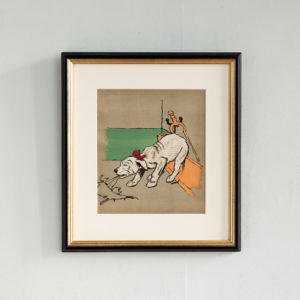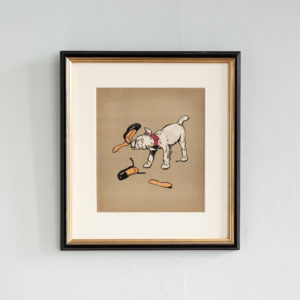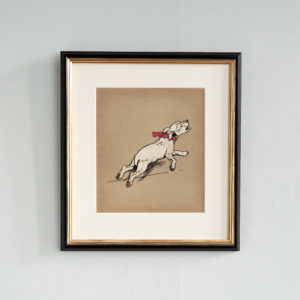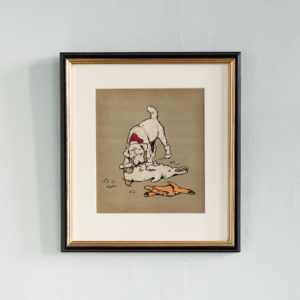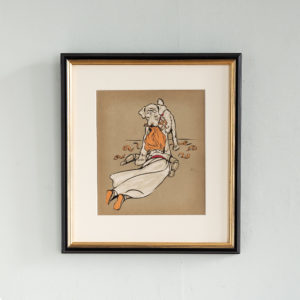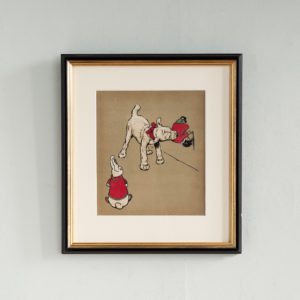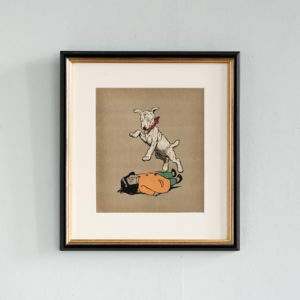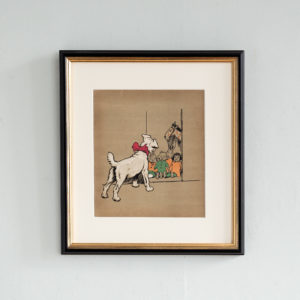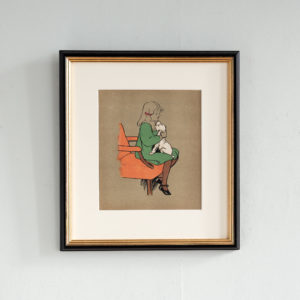951 items found
Page 3 of 10
-
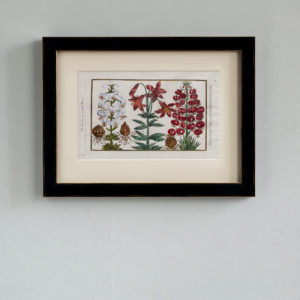
Paradisi in Sole Paradisus Terrestris by John Parkinson (1567-1650)
£350 eachParadisi in Sole Paradisus Terrestris by John Parkinson (1567-1650)
John Parkinson, born c1566, started his working life in medicine, beginning his apprenticeship to a London apothecary. He went on to become one of the most respected apothecaries in Britain. He was elected junior warden of the Society of Apothecaries in August 1620 but at the beginning of 1622, he asked for, and was granted, permission to give up his duties in the Society and then concentrated on his garden in London's Long Acre. Here he started researching and writing his first book: Paradisi in sole paradisus terrestris, and maintained close relations with other important English and Continental botanists, herbalists and plantsmen.£350 each -
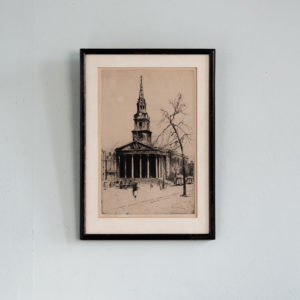
Dorothy Woollard, St. Martin in the Fields,
£350Dorothy Woollard, St. Martin in the Fields,
A framed and mounted original etching by Dorothy Woollard of St Martin-in-the-Fields church, Trafalgar Square. Signed in pencil by the artist.£350 -
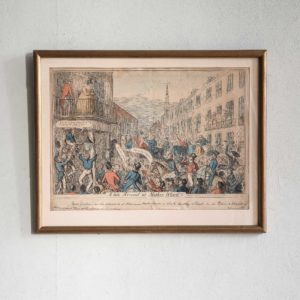
A late Arrival at Mother Wood’s
£350A late Arrival at Mother Wood’s
Hand-coloured etching by George Cruikshank, published by Mr George Humphrey. The scene depicts Caroline of Brunswick, the estranged wife of the newly ascended King George IV, saluting and addressing an adoring crowd from the balcony of Alderman Wood's residence in South Audley Street, London. Alderman Woods was a low-born hop merchant who's investments in a colouring agent for porter had supplied him with the means to further career in Radical politics. He achieved an almost unprecedented two-term mayoralty of the City of London where his opposition to the governments repressive domestic legislation and condemnation of the Peterloo massacre, as well as his perceived upstart vulgarity, made him a hate-figure for Tories and Loyalists. His Whig-Radicalism continued into his term as MP for the City of London and when, in 1820 he saw the chance to embarrass the King and his adherents by the return of his absent and unloved wife, he took it boldly. Woods persuaded Caroline of Brunswick to terminate the discreet ongoing negotiations for a settlement she had been engaged in with the King and instead return, splendidly and publicly, to the capital to assert her claim to be rightful Queen of England. Alderman Woods arranged for Caroline to be conveyed in an open carriage through the heart of London to his house on South Audley Street where she became the unlikely figure-head of Radical Whiggery in the metropolis. The diarist Charles Greville noted of the procession to the house on the 6th of June 1820: "The Queen arrived in London yesterday at seven o’clock… She travelled in an open landau, Alderman Wood sitting by her side and Lady Anne Hamilton and another woman opposite. Everybody was disgusted at the vulgarity of Wood in sitting in the place of honour, while the Duke of Hamilton’s sister was sitting backwards in the carriage". Caroline would spend the next two months at South Audley Street where the the great and the good of British radicalism paid her court amidst the crowds outside South Audley Street.£350 -
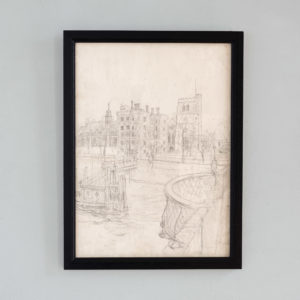
Lambeth Palace and Church by Hubert Williams (1905-1989)
£350Lambeth Palace and Church by Hubert Williams (1905-1989)
Original pencil sketch of Lambeth Palace and Church seen from the old Lambeth suspension bridge. Hubert Williams was an accomplished artist and illustrator who had the confidence to include the detail of everyday life in his views. Signed. framed£350 -
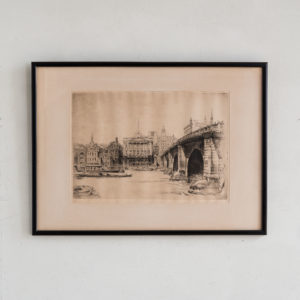
London Bridge by Frederick A Farrell (1892-1935),
£340 -
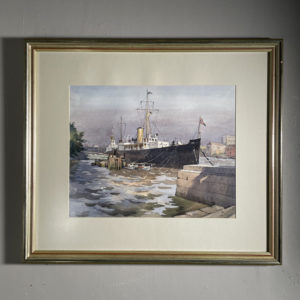
“HMS Chrysanthemum” by A. Taylor
£335 -
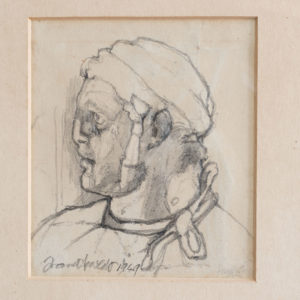
Man with Turban by Francis Hewitt
£300Man with Turban by Francis Hewitt
Pencil sketch signed and dated 49. In plain wood frame, floated within a cream mount.£300 -
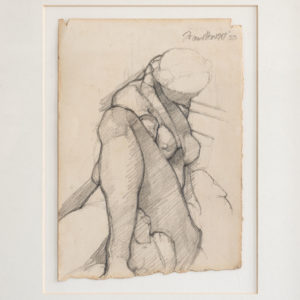
Nude Study by Francis Hewitt
£300Nude Study by Francis Hewitt
Pencil sketch signed and dated 50. In plain wood frame, floated within a cream mount.£300 -
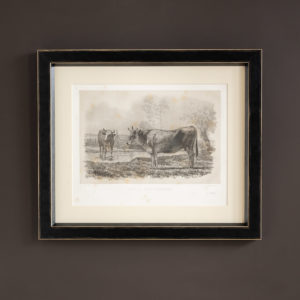
Original lithographs of Cattle Breeds published 1862, ‘Vache Parthenaise’,
£300 eachOriginal lithographs of Cattle Breeds published 1862, ‘Vache Parthenaise’,
Printed by Lemercier of Paris.£300 each -
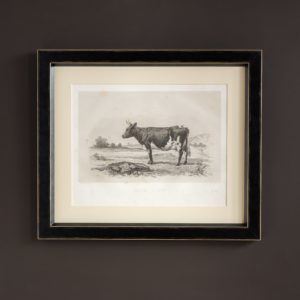
Original lithographs of Cattle Breeds published 1862, ‘Vache D’Ayr’,
£300 eachOriginal lithographs of Cattle Breeds published 1862, ‘Vache D’Ayr’,
Printed by Lemercier of Paris.£300 each -
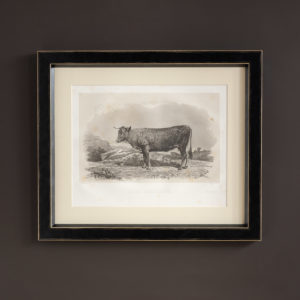
Original lithographs of Cattle Breeds published 1862, ‘Vache Garonnaise’,
£300 eachOriginal lithographs of Cattle Breeds published 1862, ‘Vache Garonnaise’,
Printed by Lemercier of Paris.£300 each -
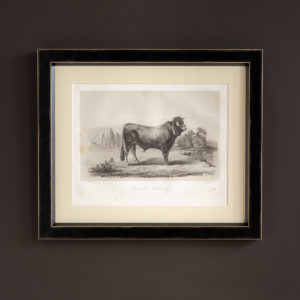
Original lithographs of Cattle Breeds published 1862, ‘Taureau Bazadais’,
£300 eachOriginal lithographs of Cattle Breeds published 1862, ‘Taureau Bazadais’,
Printed by Lemercier of Paris.£300 each -
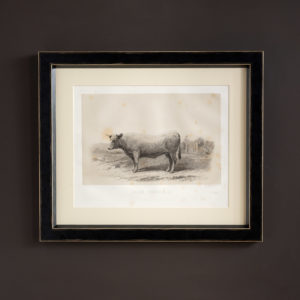
Original lithographs of Cattle Breeds published 1862, ‘Vache Charolaise’,
£300 eachOriginal lithographs of Cattle Breeds published 1862, ‘Vache Charolaise’,
Printed by Lemercier of Paris.£300 each -
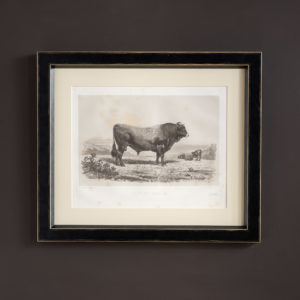
Original lithographs of Cattle Breeds published 1862, ‘Taureau Gascon’,
£300 eachOriginal lithographs of Cattle Breeds published 1862, ‘Taureau Gascon’,
Printed by Lemercier of Paris.£300 each -
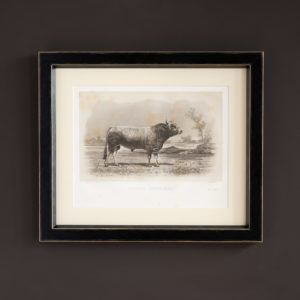
Original lithographs of Cattle Breeds published 1862, ‘Taureau Parthenais’,
£300 eachOriginal lithographs of Cattle Breeds published 1862, ‘Taureau Parthenais’,
Printed by Lemercier of Paris.£300 each -
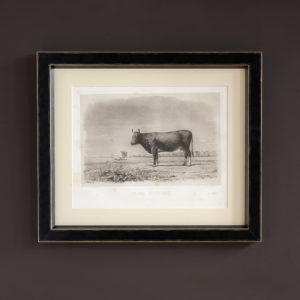
Original lithographs of Cattle Breeds published 1862, ‘Vache Bretonne’,
£300 eachOriginal lithographs of Cattle Breeds published 1862, ‘Vache Bretonne’,
Printed by Lemercier of Paris.£300 each -

Original lithographs of Cattle Breeds published 1862, ‘Taureau Garonnais’,
£300 eachOriginal lithographs of Cattle Breeds published 1862, ‘Taureau Garonnais’,
Printed by Lemercier of Paris.£300 each -
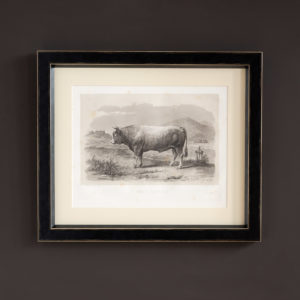
Original lithographs of Cattle Breeds published 1862, ‘Taureau Limousin’,
£300 eachOriginal lithographs of Cattle Breeds published 1862, ‘Taureau Limousin’,
Printed by Lemercier of Paris.£300 each -
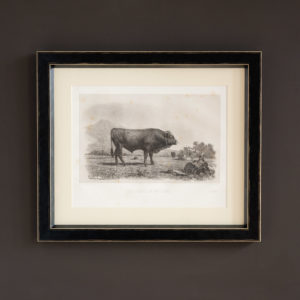
Original lithographs of Cattle Breeds published 1862, ‘Taureau D’Aubrac’,
£300 eachOriginal lithographs of Cattle Breeds published 1862, ‘Taureau D’Aubrac’,
Printed by Lemercier of Paris.£300 each -
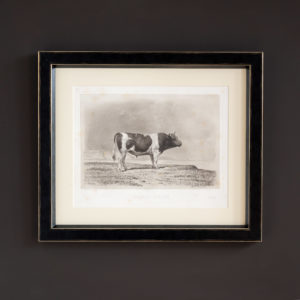
Original lithographs of Cattle Breeds published 1862, ‘Taureau Breton’,
£300 eachOriginal lithographs of Cattle Breeds published 1862, ‘Taureau Breton’,
Printed by Lemercier of Paris.£300 each -
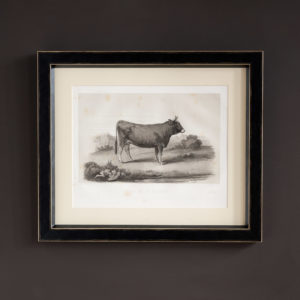
Original lithographs of Cattle Breeds published 1862, ‘Vache D’Aubrac’,
£300 eachOriginal lithographs of Cattle Breeds published 1862, ‘Vache D’Aubrac’,
Printed by Lemercier of Paris.£300 each -
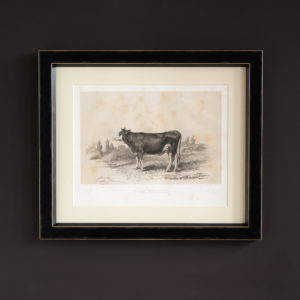
Original lithographs of Cattle Breeds published 1862, ‘Vache Mancelle’,
£300 eachOriginal lithographs of Cattle Breeds published 1862, ‘Vache Mancelle’,
Printed by Lemercier of Paris.£300 each -

Original lithographs of Cattle Breeds published 1862, ‘Taureau de Salers’,
£300 eachOriginal lithographs of Cattle Breeds published 1862, ‘Taureau de Salers’,
Printed by Lemercier of Paris.£300 each -
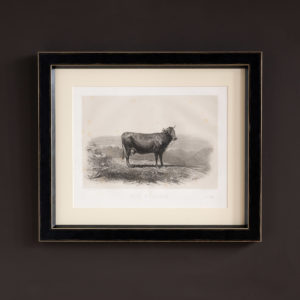
Original lithographs of Cattle Breeds published 1862, ‘Vache D’Oberhasli’,
£300 eachOriginal lithographs of Cattle Breeds published 1862, ‘Vache D’Oberhasli’,
Printed by Lemercier of Paris.£300 each -
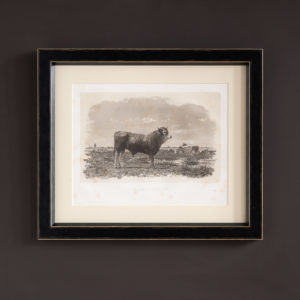
Original lithographs of Cattle Breeds published 1862, ‘Taureau Landais’,
£300 eachOriginal lithographs of Cattle Breeds published 1862, ‘Taureau Landais’,
Printed by Lemercier of Paris.£300 each -
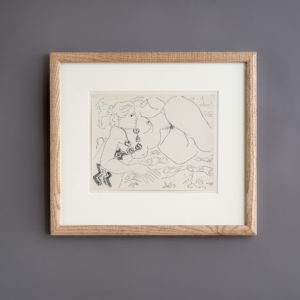
Cahiers D’Art, Dessins de Matisse
£300 eachCahiers D’Art, Dessins de Matisse
Cahiers d'Art is a French artistic and literary journal originally founded in 1926 by Christian Zervos, a Greek philosopher, editor. Born in 1889 in Argostoli on the Greek island of Cephalonia he was brought up in Alexandria, Egypt, finally moving to Paris in 1922. In 1924 Zervos joined the publishing firm Editions Morancé writing art articles for the magazine L'Art d'aujourd '. As an editor, he met many of the artists about whom the magazine wrote: Henri Matisse, Georges Braque, Ferdinand Léger, and Pablo Picasso. He left Morancé in 1926 to found his own journal Cahiers d'art becoming simultaneously publisher, director, model maker, chief editor and main editor. Each issue balanced primitive arts with the modern and contemporary arts and articles by art critics with more literary and poetic texts. According to Zervos, the interest in prehistoric, ancient and extra-European arts was necessary to get a glimpse of contemporary art. It was Zervos who took on the enormous task of documenting all the works of Pablo Picasso into a33-volume catalogue raisonnée, published between 1932 and 1978. One of his deepest wishes was to build up with Cahiers d’Art the visual archives of the artists he considered important. Zervos married Yvonne Marion who ran an art gallery, Galerie du Dragon, next to the location of her husband's shop, the rue Dragon on the left bank of Paris. Madame Zervos became an integral part of her husband's accomplishment and assembling their art collection. Initially published from 1926 to 1960 Cahiers d'Art still exists today after Swedish collector Staffan Ahrenberg purchased the publication and relaunched it in October 2012.£300 each -
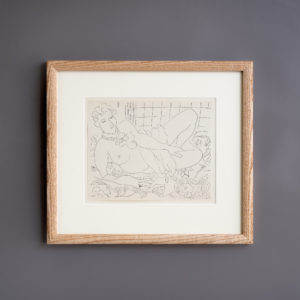
Cahiers D’Art, Dessins de Matisse
£300 eachCahiers D’Art, Dessins de Matisse
Cahiers d'Art is a French artistic and literary journal originally founded in 1926 by Christian Zervos, a Greek philosopher, editor. Born in 1889 in Argostoli on the Greek island of Cephalonia he was brought up in Alexandria, Egypt, finally moving to Paris in 1922. In 1924 Zervos joined the publishing firm Editions Morancé writing art articles for the magazine L'Art d'aujourd '. As an editor, he met many of the artists about whom the magazine wrote: Henri Matisse, Georges Braque, Ferdinand Léger, and Pablo Picasso. He left Morancé in 1926 to found his own journal Cahiers d'art becoming simultaneously publisher, director, model maker, chief editor and main editor. Each issue balanced primitive arts with the modern and contemporary arts and articles by art critics with more literary and poetic texts. According to Zervos, the interest in prehistoric, ancient and extra-European arts was necessary to get a glimpse of contemporary art. It was Zervos who took on the enormous task of documenting all the works of Pablo Picasso into a33-volume catalogue raisonnée, published between 1932 and 1978. One of his deepest wishes was to build up with Cahiers d’Art the visual archives of the artists he considered important. Zervos married Yvonne Marion who ran an art gallery, Galerie du Dragon, next to the location of her husband's shop, the rue Dragon on the left bank of Paris. Madame Zervos became an integral part of her husband's accomplishment and assembling their art collection. Initially published from 1926 to 1960 Cahiers d'Art still exists today after Swedish collector Staffan Ahrenberg purchased the publication and relaunched it in October 2012.£300 each -
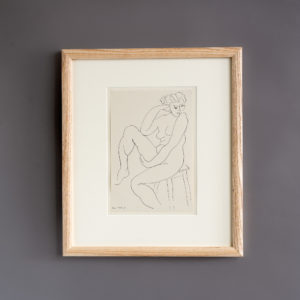
Cahiers D’Art, Dessins de Matisse
£300 eachCahiers D’Art, Dessins de Matisse
Cahiers d'Art is a French artistic and literary journal originally founded in 1926 by Christian Zervos, a Greek philosopher, editor. Born in 1889 in Argostoli on the Greek island of Cephalonia he was brought up in Alexandria, Egypt, finally moving to Paris in 1922. In 1924 Zervos joined the publishing firm Editions Morancé writing art articles for the magazine L'Art d'aujourd '. As an editor, he met many of the artists about whom the magazine wrote: Henri Matisse, Georges Braque, Ferdinand Léger, and Pablo Picasso. He left Morancé in 1926 to found his own journal Cahiers d'art becoming simultaneously publisher, director, model maker, chief editor and main editor. Each issue balanced primitive arts with the modern and contemporary arts and articles by art critics with more literary and poetic texts. According to Zervos, the interest in prehistoric, ancient and extra-European arts was necessary to get a glimpse of contemporary art. It was Zervos who took on the enormous task of documenting all the works of Pablo Picasso into a33-volume catalogue raisonnée, published between 1932 and 1978. One of his deepest wishes was to build up with Cahiers d’Art the visual archives of the artists he considered important. Zervos married Yvonne Marion who ran an art gallery, Galerie du Dragon, next to the location of her husband's shop, the rue Dragon on the left bank of Paris. Madame Zervos became an integral part of her husband's accomplishment and assembling their art collection. Initially published from 1926 to 1960 Cahiers d'Art still exists today after Swedish collector Staffan Ahrenberg purchased the publication and relaunched it in October 2012.£300 each -
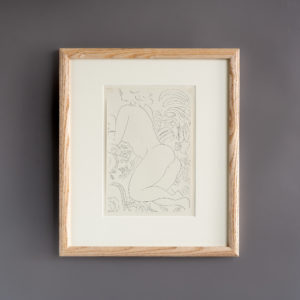
Cahiers D’Art, Dessins de Matisse
£300 eachCahiers D’Art, Dessins de Matisse
Cahiers d'Art is a French artistic and literary journal originally founded in 1926 by Christian Zervos, a Greek philosopher, editor. Born in 1889 in Argostoli on the Greek island of Cephalonia he was brought up in Alexandria, Egypt, finally moving to Paris in 1922. In 1924 Zervos joined the publishing firm Editions Morancé writing art articles for the magazine L'Art d'aujourd '. As an editor, he met many of the artists about whom the magazine wrote: Henri Matisse, Georges Braque, Ferdinand Léger, and Pablo Picasso. He left Morancé in 1926 to found his own journal Cahiers d'art becoming simultaneously publisher, director, model maker, chief editor and main editor. Each issue balanced primitive arts with the modern and contemporary arts and articles by art critics with more literary and poetic texts. According to Zervos, the interest in prehistoric, ancient and extra-European arts was necessary to get a glimpse of contemporary art. It was Zervos who took on the enormous task of documenting all the works of Pablo Picasso into a33-volume catalogue raisonnée, published between 1932 and 1978. One of his deepest wishes was to build up with Cahiers d’Art the visual archives of the artists he considered important. Zervos married Yvonne Marion who ran an art gallery, Galerie du Dragon, next to the location of her husband's shop, the rue Dragon on the left bank of Paris. Madame Zervos became an integral part of her husband's accomplishment and assembling their art collection. Initially published from 1926 to 1960 Cahiers d'Art still exists today after Swedish collector Staffan Ahrenberg purchased the publication and relaunched it in October 2012.£300 each -
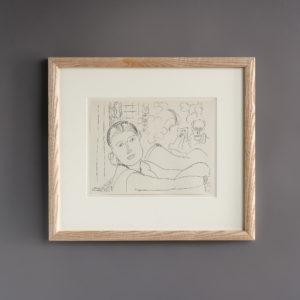
Cahiers D’Art, Dessins de Matisse
£300 eachCahiers D’Art, Dessins de Matisse
Cahiers d'Art is a French artistic and literary journal originally founded in 1926 by Christian Zervos, a Greek philosopher, editor. Born in 1889 in Argostoli on the Greek island of Cephalonia he was brought up in Alexandria, Egypt, finally moving to Paris in 1922. In 1924 Zervos joined the publishing firm Editions Morancé writing art articles for the magazine L'Art d'aujourd '. As an editor, he met many of the artists about whom the magazine wrote: Henri Matisse, Georges Braque, Ferdinand Léger, and Pablo Picasso. He left Morancé in 1926 to found his own journal Cahiers d'art becoming simultaneously publisher, director, model maker, chief editor and main editor. Each issue balanced primitive arts with the modern and contemporary arts and articles by art critics with more literary and poetic texts. According to Zervos, the interest in prehistoric, ancient and extra-European arts was necessary to get a glimpse of contemporary art. It was Zervos who took on the enormous task of documenting all the works of Pablo Picasso into a33-volume catalogue raisonnée, published between 1932 and 1978. One of his deepest wishes was to build up with Cahiers d’Art the visual archives of the artists he considered important. Zervos married Yvonne Marion who ran an art gallery, Galerie du Dragon, next to the location of her husband's shop, the rue Dragon on the left bank of Paris. Madame Zervos became an integral part of her husband's accomplishment and assembling their art collection. Initially published from 1926 to 1960 Cahiers d'Art still exists today after Swedish collector Staffan Ahrenberg purchased the publication and relaunched it in October 2012.£300 each -
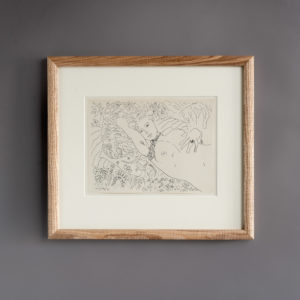
Cahiers D’Art, Dessins de Matisse
£300 eachCahiers D’Art, Dessins de Matisse
Cahiers d'Art is a French artistic and literary journal originally founded in 1926 by Christian Zervos, a Greek philosopher, editor. Born in 1889 in Argostoli on the Greek island of Cephalonia he was brought up in Alexandria, Egypt, finally moving to Paris in 1922. In 1924 Zervos joined the publishing firm Editions Morancé writing art articles for the magazine L'Art d'aujourd '. As an editor, he met many of the artists about whom the magazine wrote: Henri Matisse, Georges Braque, Ferdinand Léger, and Pablo Picasso. He left Morancé in 1926 to found his own journal Cahiers d'art becoming simultaneously publisher, director, model maker, chief editor and main editor. Each issue balanced primitive arts with the modern and contemporary arts and articles by art critics with more literary and poetic texts. According to Zervos, the interest in prehistoric, ancient and extra-European arts was necessary to get a glimpse of contemporary art. It was Zervos who took on the enormous task of documenting all the works of Pablo Picasso into a33-volume catalogue raisonnée, published between 1932 and 1978. One of his deepest wishes was to build up with Cahiers d’Art the visual archives of the artists he considered important. Zervos married Yvonne Marion who ran an art gallery, Galerie du Dragon, next to the location of her husband's shop, the rue Dragon on the left bank of Paris. Madame Zervos became an integral part of her husband's accomplishment and assembling their art collection. Initially published from 1926 to 1960 Cahiers d'Art still exists today after Swedish collector Staffan Ahrenberg purchased the publication and relaunched it in October 2012.£300 each -
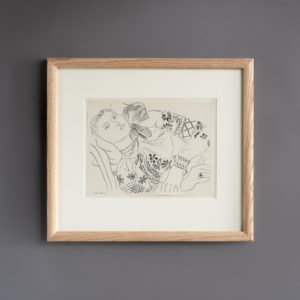
Cahiers D’Art, Dessins de Matisse
£300 eachCahiers D’Art, Dessins de Matisse
Cahiers d'Art is a French artistic and literary journal originally founded in 1926 by Christian Zervos, a Greek philosopher, editor. Born in 1889 in Argostoli on the Greek island of Cephalonia he was brought up in Alexandria, Egypt, finally moving to Paris in 1922. In 1924 Zervos joined the publishing firm Editions Morancé writing art articles for the magazine L'Art d'aujourd '. As an editor, he met many of the artists about whom the magazine wrote: Henri Matisse, Georges Braque, Ferdinand Léger, and Pablo Picasso. He left Morancé in 1926 to found his own journal Cahiers d'art becoming simultaneously publisher, director, model maker, chief editor and main editor. Each issue balanced primitive arts with the modern and contemporary arts and articles by art critics with more literary and poetic texts. According to Zervos, the interest in prehistoric, ancient and extra-European arts was necessary to get a glimpse of contemporary art. It was Zervos who took on the enormous task of documenting all the works of Pablo Picasso into a33-volume catalogue raisonnée, published between 1932 and 1978. One of his deepest wishes was to build up with Cahiers d’Art the visual archives of the artists he considered important. Zervos married Yvonne Marion who ran an art gallery, Galerie du Dragon, next to the location of her husband's shop, the rue Dragon on the left bank of Paris. Madame Zervos became an integral part of her husband's accomplishment and assembling their art collection. Initially published from 1926 to 1960 Cahiers d'Art still exists today after Swedish collector Staffan Ahrenberg purchased the publication and relaunched it in October 2012.£300 each -
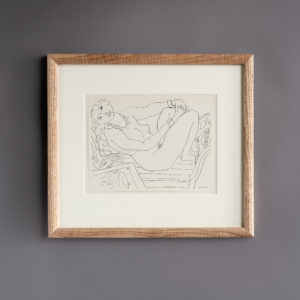
Cahiers D’Art, Dessins de Matisse
£300 eachCahiers D’Art, Dessins de Matisse
Cahiers d'Art is a French artistic and literary journal originally founded in 1926 by Christian Zervos, a Greek philosopher, editor. Born in 1889 in Argostoli on the Greek island of Cephalonia he was brought up in Alexandria, Egypt, finally moving to Paris in 1922. In 1924 Zervos joined the publishing firm Editions Morancé writing art articles for the magazine L'Art d'aujourd '. As an editor, he met many of the artists about whom the magazine wrote: Henri Matisse, Georges Braque, Ferdinand Léger, and Pablo Picasso. He left Morancé in 1926 to found his own journal Cahiers d'art becoming simultaneously publisher, director, model maker, chief editor and main editor. Each issue balanced primitive arts with the modern and contemporary arts and articles by art critics with more literary and poetic texts. According to Zervos, the interest in prehistoric, ancient and extra-European arts was necessary to get a glimpse of contemporary art. It was Zervos who took on the enormous task of documenting all the works of Pablo Picasso into a33-volume catalogue raisonnée, published between 1932 and 1978. One of his deepest wishes was to build up with Cahiers d’Art the visual archives of the artists he considered important. Zervos married Yvonne Marion who ran an art gallery, Galerie du Dragon, next to the location of her husband's shop, the rue Dragon on the left bank of Paris. Madame Zervos became an integral part of her husband's accomplishment and assembling their art collection. Initially published from 1926 to 1960 Cahiers d'Art still exists today after Swedish collector Staffan Ahrenberg purchased the publication and relaunched it in October 2012.£300 each -
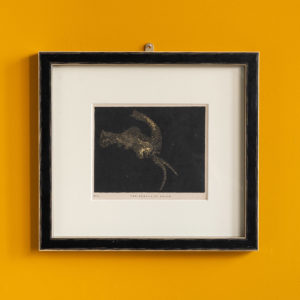
“The Beauty of the Heavens: A Pictorial Display of The Astronomical Phenomena of The Universe” by Charles Blunt, ‘The Nebula of Orion’,
£295 each“The Beauty of the Heavens: A Pictorial Display of The Astronomical Phenomena of The Universe” by Charles Blunt, ‘The Nebula of Orion’,
In the mid-19th century, Home Education had become very popular for the masses and lecturer, Charles Blunt seeing a gap in the market came up with these illustrations. Blunt who specialised in astronomy and natural philosophy, saw the need for a series of ‘accurate yet popular’ plates illustrating the known Universe. These hand-finished aquatints prints were based on Blunt’s own drawings, depicting celestial and astrological subjects.£295 each -
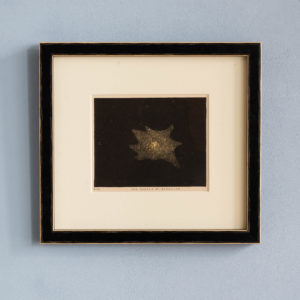
“The Beauty of the Heavens: A Pictorial Display of The Astronomical Phenomena of The Universe” by Charles Blunt, ‘The Nebula of Hercules’,
£295 each“The Beauty of the Heavens: A Pictorial Display of The Astronomical Phenomena of The Universe” by Charles Blunt, ‘The Nebula of Hercules’,
In the mid-19th century, Home Education had become very popular for the masses and lecturer, Charles Blunt seeing a gap in the market came up with these illustrations. Blunt who specialised in astronomy and natural philosophy, saw the need for a series of ‘accurate yet popular’ plates illustrating the known Universe. These hand-finished aquatints prints were based on Blunt’s own drawings, depicting celestial and astrological subjects.£295 each -
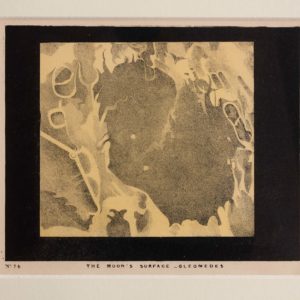
“The Beauty of the Heavens: A Pictorial Display of The Astronomical Phenomena of The Universe” by Charles Blunt, ‘The Moon’s Surface – Cleomedes’,
£295 each“The Beauty of the Heavens: A Pictorial Display of The Astronomical Phenomena of The Universe” by Charles Blunt, ‘The Moon’s Surface – Cleomedes’,
In the mid-19th century, Home Education had become very popular for the masses and lecturer, Charles Blunt seeing a gap in the market came up with these illustrations. Blunt who specialised in astronomy and natural philosophy, saw the need for a series of ‘accurate yet popular’ plates illustrating the known Universe. These hand-finished aquatints prints were based on Blunt’s own drawings, depicting celestial and astrological subjects.£295 each -
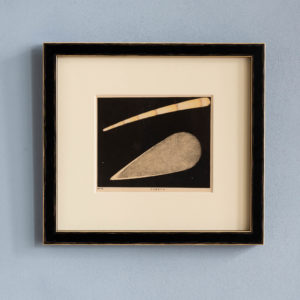
“The Beauty of the Heavens: A Pictorial Display of The Astronomical Phenomena of The Universe” by Charles Blunt, ‘Comets’,
£295 each“The Beauty of the Heavens: A Pictorial Display of The Astronomical Phenomena of The Universe” by Charles Blunt, ‘Comets’,
In the mid-19th century, Home Education had become very popular for the masses and lecturer, Charles Blunt seeing a gap in the market came up with these illustrations. Blunt who specialised in astronomy and natural philosophy, saw the need for a series of ‘accurate yet popular’ plates illustrating the known Universe. These hand-finished aquatints prints were based on Blunt’s own drawings, depicting celestial and astrological subjects.£295 each -
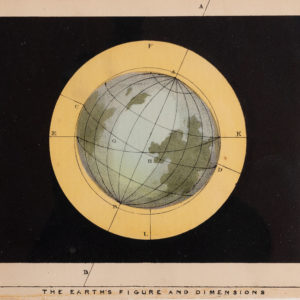
“The Beauty of the Heavens: A Pictorial Display of The Astronomical Phenomena of The Universe” by Charles Blunt, ‘The Earth’s Figure and Dimensions’,
£295 each“The Beauty of the Heavens: A Pictorial Display of The Astronomical Phenomena of The Universe” by Charles Blunt, ‘The Earth’s Figure and Dimensions’,
In the mid-19th century, Home Education had become very popular for the masses and lecturer, Charles Blunt seeing a gap in the market came up with these illustrations. Blunt who specialised in astronomy and natural philosophy, saw the need for a series of ‘accurate yet popular’ plates illustrating the known Universe. These hand-finished aquatints prints were based on Blunt’s own drawings, depicting celestial and astrological subjects.£295 each -
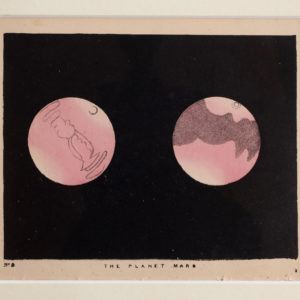
“The Beauty of the Heavens: A Pictorial Display of The Astronomical Phenomena of The Universe” by Charles Blunt, ‘The Planet Mars’,
£295 each“The Beauty of the Heavens: A Pictorial Display of The Astronomical Phenomena of The Universe” by Charles Blunt, ‘The Planet Mars’,
In the mid-19th century, Home Education had become very popular for the masses and lecturer, Charles Blunt seeing a gap in the market came up with these illustrations. Blunt who specialised in astronomy and natural philosophy, saw the need for a series of ‘accurate yet popular’ plates illustrating the known Universe. These hand-finished aquatints prints were based on Blunt’s own drawings, depicting celestial and astrological subjects.£295 each -
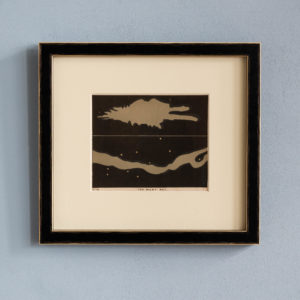
“The Beauty of the Heavens: A Pictorial Display of The Astronomical Phenomena of The Universe” by Charles Blunt, ‘The Milky Way’,
£295 each“The Beauty of the Heavens: A Pictorial Display of The Astronomical Phenomena of The Universe” by Charles Blunt, ‘The Milky Way’,
In the mid-19th century, Home Education had become very popular for the masses and lecturer, Charles Blunt seeing a gap in the market came up with these illustrations. Blunt who specialised in astronomy and natural philosophy, saw the need for a series of ‘accurate yet popular’ plates illustrating the known Universe. These hand-finished aquatints prints were based on Blunt’s own drawings, depicting celestial and astrological subjects.£295 each -
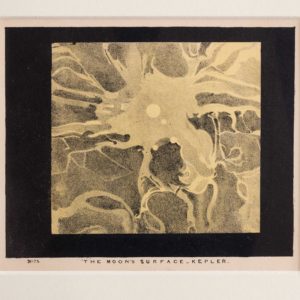
“The Beauty of the Heavens: A Pictorial Display of The Astronomical Phenomena of The Universe” by Charles Blunt, ‘The Moon’s Surface – Kepler’,
£295 each“The Beauty of the Heavens: A Pictorial Display of The Astronomical Phenomena of The Universe” by Charles Blunt, ‘The Moon’s Surface – Kepler’,
In the mid-19th century, Home Education had become very popular for the masses and lecturer, Charles Blunt seeing a gap in the market came up with these illustrations. Blunt who specialised in astronomy and natural philosophy, saw the need for a series of ‘accurate yet popular’ plates illustrating the known Universe. These hand-finished aquatints prints were based on Blunt’s own drawings, depicting celestial and astrological subjects.£295 each -
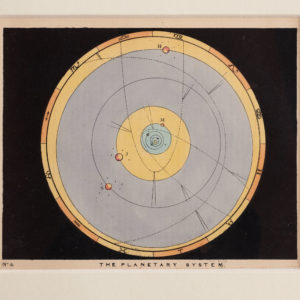
“The Beauty of the Heavens: A Pictorial Display of The Astronomical Phenomena of The Universe” by Charles Blunt, ‘The Planetary System’,
£295 each“The Beauty of the Heavens: A Pictorial Display of The Astronomical Phenomena of The Universe” by Charles Blunt, ‘The Planetary System’,
In the mid-19th century, Home Education had become very popular for the masses and lecturer, Charles Blunt seeing a gap in the market came up with these illustrations. Blunt who specialised in astronomy and natural philosophy, saw the need for a series of ‘accurate yet popular’ plates illustrating the known Universe. These hand-finished aquatints prints were based on Blunt’s own drawings, depicting celestial and astrological subjects.£295 each -
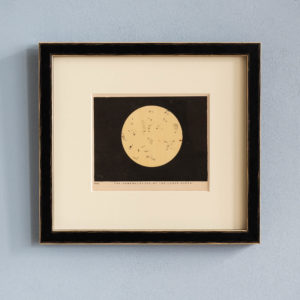
“The Beauty of the Heavens: A Pictorial Display of The Astronomical Phenomena of The Universe” by Charles Blunt, ‘The Nomenclature of the Lunar Spots’,
£295 each“The Beauty of the Heavens: A Pictorial Display of The Astronomical Phenomena of The Universe” by Charles Blunt, ‘The Nomenclature of the Lunar Spots’,
In the mid-19th century, Home Education had become very popular for the masses and lecturer, Charles Blunt seeing a gap in the market came up with these illustrations. Blunt who specialised in astronomy and natural philosophy, saw the need for a series of ‘accurate yet popular’ plates illustrating the known Universe. These hand-finished aquatints prints were based on Blunt’s own drawings, depicting celestial and astrological subjects.£295 each -
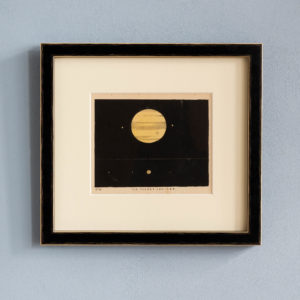
“The Beauty of the Heavens: A Pictorial Display of The Astronomical Phenomena of The Universe” by Charles Blunt, ‘The Planet Jupiter’,
£295 each“The Beauty of the Heavens: A Pictorial Display of The Astronomical Phenomena of The Universe” by Charles Blunt, ‘The Planet Jupiter’,
In the mid-19th century, Home Education had become very popular for the masses and lecturer, Charles Blunt seeing a gap in the market came up with these illustrations. Blunt who specialised in astronomy and natural philosophy, saw the need for a series of ‘accurate yet popular’ plates illustrating the known Universe. These hand-finished aquatints prints were based on Blunt’s own drawings, depicting celestial and astrological subjects.£295 each -

“The Beauty of the Heavens: A Pictorial Display of The Astronomical Phenomena of The Universe” by Charles Blunt, ‘The Moon Gibbous’,
£295 each“The Beauty of the Heavens: A Pictorial Display of The Astronomical Phenomena of The Universe” by Charles Blunt, ‘The Moon Gibbous’,
In the mid-19th century, Home Education had become very popular for the masses and lecturer, Charles Blunt seeing a gap in the market came up with these illustrations. Blunt who specialised in astronomy and natural philosophy, saw the need for a series of ‘accurate yet popular’ plates illustrating the known Universe. These hand-finished aquatints prints were based on Blunt’s own drawings, depicting celestial and astrological subjects.£295 each -
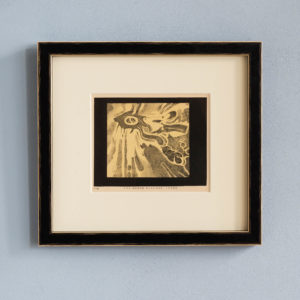
“The Beauty of the Heavens: A Pictorial Display of The Astronomical Phenomena of The Universe” by Charles Blunt, ‘The Moon’s Surface – Tycho’,
£295 each“The Beauty of the Heavens: A Pictorial Display of The Astronomical Phenomena of The Universe” by Charles Blunt, ‘The Moon’s Surface – Tycho’,
In the mid-19th century, Home Education had become very popular for the masses and lecturer, Charles Blunt seeing a gap in the market came up with these illustrations. Blunt who specialised in astronomy and natural philosophy, saw the need for a series of ‘accurate yet popular’ plates illustrating the known Universe. These hand-finished aquatints prints were based on Blunt’s own drawings, depicting celestial and astrological subjects.£295 each -
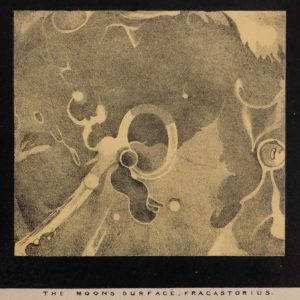
“The Beauty of the Heavens: A Pictorial Display of The Astronomical Phenomena of The Universe” by Charles Blunt, ‘The Moon’s Surface’,
£295 each“The Beauty of the Heavens: A Pictorial Display of The Astronomical Phenomena of The Universe” by Charles Blunt, ‘The Moon’s Surface’,
In the mid-19th century, Home Education had become very popular for the masses and lecturer, Charles Blunt seeing a gap in the market came up with these illustrations. Blunt who specialised in astronomy and natural philosophy, saw the need for a series of ‘accurate yet popular’ plates illustrating the known Universe. These hand-finished aquatints prints were based on Blunt’s own drawings, depicting celestial and astrological subjects.£295 each -
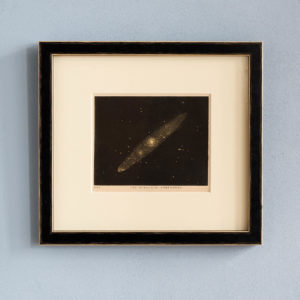
“The Beauty of the Heavens: A Pictorial Display of The Astronomical Phenomena of The Universe” by Charles Blunt, ‘The Nebula of Andromeda’,
£295 each“The Beauty of the Heavens: A Pictorial Display of The Astronomical Phenomena of The Universe” by Charles Blunt, ‘The Nebula of Andromeda’,
In the mid-19th century, Home Education had become very popular for the masses and lecturer, Charles Blunt seeing a gap in the market came up with these illustrations. Blunt who specialised in astronomy and natural philosophy, saw the need for a series of ‘accurate yet popular’ plates illustrating the known Universe. These hand-finished aquatints prints were based on Blunt’s own drawings, depicting celestial and astrological subjects.£295 each -

Picasso, Verve 1954
£295Picasso, Verve 1954
Original héliogravure print from Verve Vol. VIII, No 29/30 printed by the Master Printers Draeger Frères in 1954. Framed in black with a cream mount.£295 -
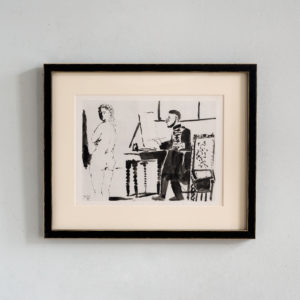
Picasso, Verve 1954
£295Picasso, Verve 1954
Original héliogravure print from Verve Vol. VIII, No 29/30 printed by the Master Printers Draeger Frères in 1954. Framed in black with a cream mount.£295 -
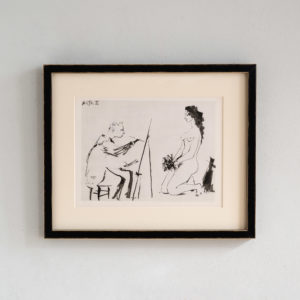
Picasso, Verve 1954
£295Picasso, Verve 1954
Original héliogravure print from Verve Vol. VIII, No 29/30 printed by the Master Printers Draeger Frères in 1954. Framed in black with a cream mount.£295 -
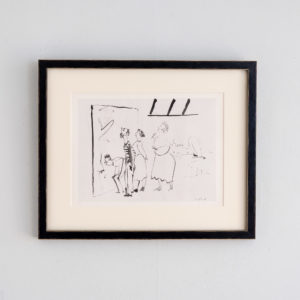
Picasso, Verve 1954
£295Picasso, Verve 1954
Original héliogravure print from Verve Vol. VIII, No 29/30 printed by the Master Printers Draeger Frères in 1954. Framed in black with a cream mount.£295 -
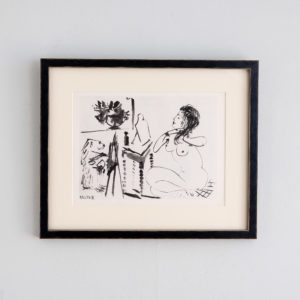
Picasso, Verve 1954
£295Picasso, Verve 1954
Original héliogravure print from Verve Vol. VIII, No 29/30 printed by the Master Printers Draeger Frères in 1954. Framed in black with a cream mount.£295 -
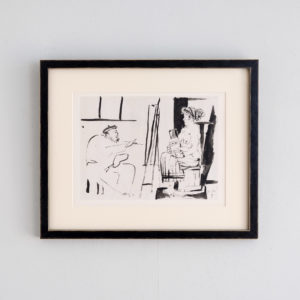
Picasso, Verve 1954
£295Picasso, Verve 1954
Original héliogravure print from Verve Vol. VIII, No 29/30 printed by the Master Printers Draeger Frères in 1954. Framed in black with a cream mount.£295 -
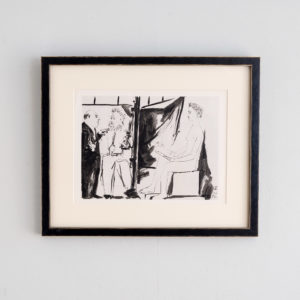
Picasso, Verve 1954
£295Picasso, Verve 1954
Original héliogravure print from Verve Vol. VIII, No 29/30 printed by the Master Printers Draeger Frères in 1954. Framed in black with a cream mount.£295 -
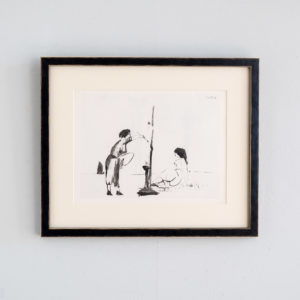
Picasso, Verve 1954
£295Picasso, Verve 1954
Original heliograuvre print from Verve Vol. VIII, No 29/30 printed by the Master Printers Draeger Frères in 1954. Framed in black with a cream mount.£295 -
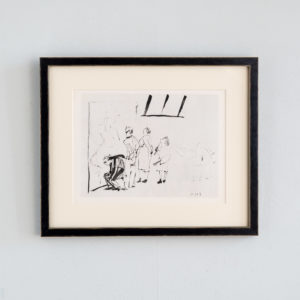
Picasso, Verve 1954
£295Picasso, Verve 1954
Original héliogravure print from Verve Vol. VIII, No 29/30 printed by the Master Printers Draeger Frères in 1954. Framed in black with a cream mount.£295 -
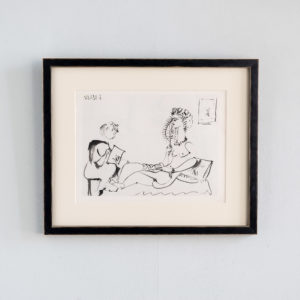
Picasso, Verve 1954
£295Picasso, Verve 1954
Original héliogravure print from Verve Vol. VIII, No 29/30 printed by the Master Printers Draeger Frères in 1954. Framed in black with a cream mount.£295 -
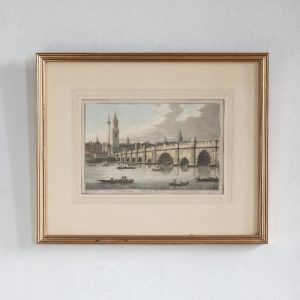
London Bridge
£295 -
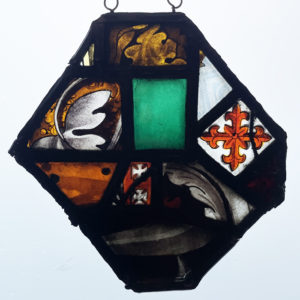
An English leaded stained glass hanger,
£290An English leaded stained glass hanger,
a polygonal light incorporating old fragments (some probably medieval): with Maltese crosses and foliate fragments, chain hung from wire loops,£290 -
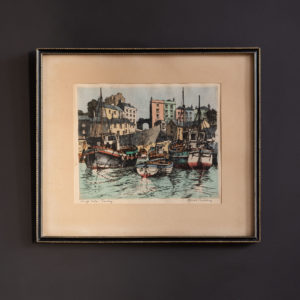
High Tide, Tenby.
£280High Tide, Tenby.
A framed aquatint by the English painter and printmaker James Priddey FRSA showing a group of small boats and fishing craft huddled beside the sea wall of Tenby harbour on the Pembrokeshire coast.£280 -
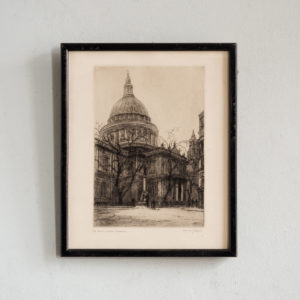
St. Pauls from Cheapside
£280St. Pauls from Cheapside
A framed pencil drawing by Dorothy Sweet showing the northern transept and part of the north quire aisle of St Pauls over St Pauls Churchyard, viewed from the the junction of Cheapside and Paternoster Row. Signed by the artist in pencil.£280 -
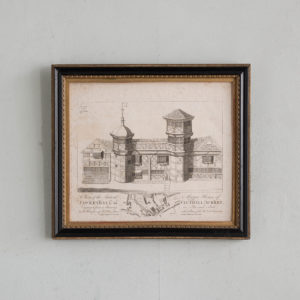
View of the Antient Manor House of Fawkeshall
£280View of the Antient Manor House of Fawkeshall
Historical engraving featuring a map of the area. Presented in a Hogarth pattern frame.£280 -
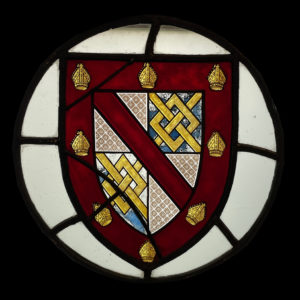
An armorial leaded and stained glass hanger,
£275An armorial leaded and stained glass hanger,
the round pane, a shield device within, the quartered field with gold 'frets' on worn blue background, gold Bishops' mitres to the red border, facing lead restorations, wire eye to the top for hanging,£275 -
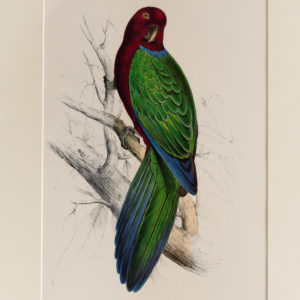
Parrots by Edward Lear – Tabuan Parrakeet,
£275Parrots by Edward Lear – Tabuan Parrakeet,
Edward Lear began his career as a zoological illustrator, working in the Parrot House at London Zoo. This resulted in the publication of Illustrations of the family of Psittacidae, or parrots, the greater part of them species hitherto unfigured in 1832. The first plates for the book were issued in 1830 when he was still only 18.£275 -
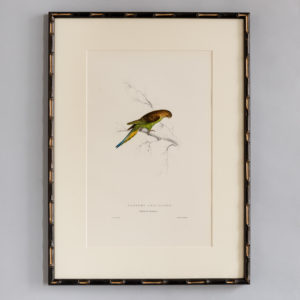
Parrots by Edward Lear – Undulated Parrakeet,
£275Parrots by Edward Lear – Undulated Parrakeet,
Edward Lear began his career as a zoological illustrator, working in the Parrot House at London Zoo. This resulted in the publication of Illustrations of the family of Psittacidae, or parrots, the greater part of them species hitherto unfigured in 1832. The first plates for the book were issued in 1830 when he was still only 18.£275 -
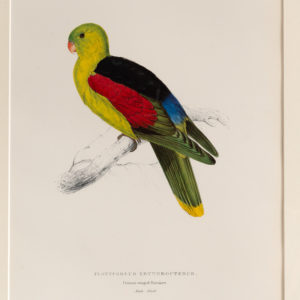
Parrots by Edward Lear – Crimson-winged Parrakeet,
£275Parrots by Edward Lear – Crimson-winged Parrakeet,
Edward Lear began his career as a zoological illustrator, working in the Parrot House at London Zoo. This resulted in the publication of Illustrations of the family of Psittacidae, or parrots, the greater part of them species hitherto unfigured in 1832. The first plates for the book were issued in 1830 when he was still only 18.£275 -
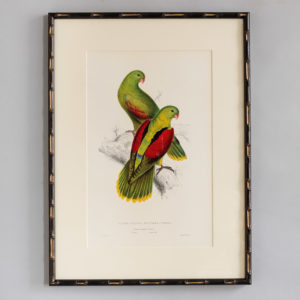
Parrots by Edward Lear – Crimson-winged Parrakeet,
£275Parrots by Edward Lear – Crimson-winged Parrakeet,
Edward Lear began his career as a zoological illustrator, working in the Parrot House at London Zoo. This resulted in the publication of Illustrations of the family of Psittacidae, or parrots, the greater part of them species hitherto unfigured in 1832. The first plates for the book were issued in 1830 when he was still only 18.£275 -
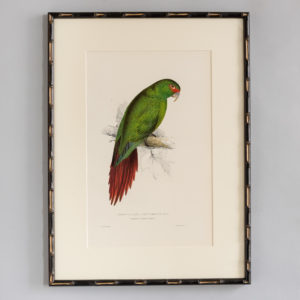
Parrots by Edward Lear – Long-billed Parrakeet-Maccaw,
£275Parrots by Edward Lear – Long-billed Parrakeet-Maccaw,
Edward Lear began his career as a zoological illustrator, working in the Parrot House at London Zoo. This resulted in the publication of Illustrations of the family of Psittacidae, or parrots, the greater part of them species hitherto unfigured in 1832. The first plates for the book were issued in 1830 when he was still only 18.£275 -
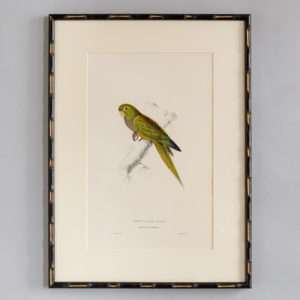
Parrots by Edward Lear – Dwarf Parrakeet Maccaw,
£275Parrots by Edward Lear – Dwarf Parrakeet Maccaw,
Edward Lear began his career as a zoological illustrator, working in the Parrot House at London Zoo. This resulted in the publication of Illustrations of the family of Psittacidae, or parrots, the greater part of them species hitherto unfigured in 1832. The first plates for the book were issued in 1830 when he was still only 18.£275 -
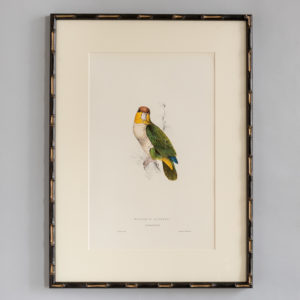
Parrots by Edward Lear – Bay-headed Parrot,
£275Parrots by Edward Lear – Bay-headed Parrot,
Edward Lear began his career as a zoological illustrator, working in the Parrot House at London Zoo. This resulted in the publication of Illustrations of the family of Psittacidae, or parrots, the greater part of them species hitherto unfigured in 1832. The first plates for the book were issued in 1830 when he was still only 18.£275 -
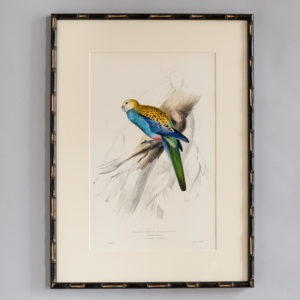
Parrots by Edward Lear – Paleheaded Parrakeet,
£275Parrots by Edward Lear – Paleheaded Parrakeet,
Edward Lear began his career as a zoological illustrator, working in the Parrot House at London Zoo. This resulted in the publication of Illustrations of the family of Psittacidae, or parrots, the greater part of them species hitherto unfigured in 1832. The first plates for the book were issued in 1830 when he was still only 18.£275 -
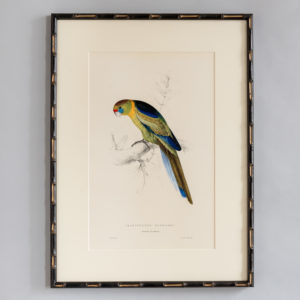
Parrots by Edward Lear – Barnard’s Parrakeet,
£275Parrots by Edward Lear – Barnard’s Parrakeet,
Edward Lear began his career as a zoological illustrator, working in the Parrot House at London Zoo. This resulted in the publication of Illustrations of the family of Psittacidae, or parrots, the greater part of them species hitherto unfigured in 1832. The first plates for the book were issued in 1830 when he was still only 18.£275 -
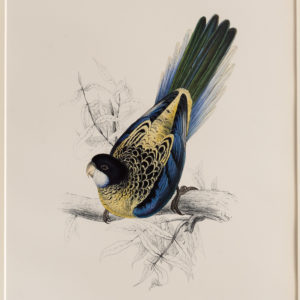
Parrots by Edward Lear – Brown’s Parrakeet,
£275Parrots by Edward Lear – Brown’s Parrakeet,
Edward Lear began his career as a zoological illustrator, working in the Parrot House at London Zoo. This resulted in the publication of Illustrations of the family of Psittacidae, or parrots, the greater part of them species hitherto unfigured in 1832. The first plates for the book were issued in 1830 when he was still only 18.£275 -
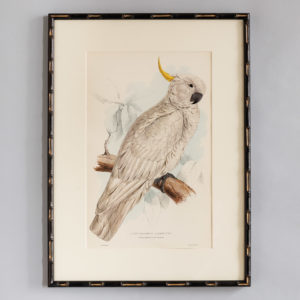
Parrots by Edward Lear – Greater Sulphur-crested Cockatoo,
£275Parrots by Edward Lear – Greater Sulphur-crested Cockatoo,
Edward Lear began his career as a zoological illustrator, working in the Parrot House at London Zoo. This resulted in the publication of Illustrations of the family of Psittacidae, or parrots, the greater part of them species hitherto unfigured in 1832. The first plates for the book were issued in 1830 when he was still only 18.£275 -
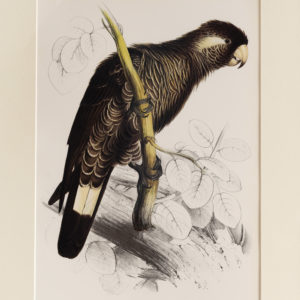
Parrots by Edward Lear – Baudin’s Cockatoo
£275Parrots by Edward Lear – Baudin’s Cockatoo
Edward Lear began his career as a zoological illustrator, working in the Parrot House at London Zoo. This resulted in the publication of Illustrations of the family of Psittacidae, or parrots, the greater part of them species hitherto unfigured in 1832. The first plates for the book were issued in 1830 when he was still only 18.£275 -
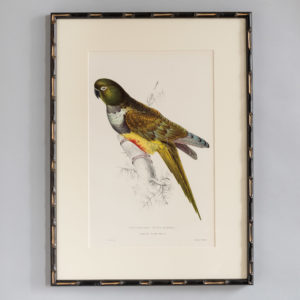
Parrots by Edward Lear – Patagonian Parrakeet-Maccaw
£275Parrots by Edward Lear – Patagonian Parrakeet-Maccaw
Edward Lear began his career as a zoological illustrator, working in the Parrot House at London Zoo. This resulted in the publication of Illustrations of the family of Psittacidae, or parrots, the greater part of them species hitherto unfigured in 1832. The first plates for the book were issued in 1830 when he was still only 18.£275 -
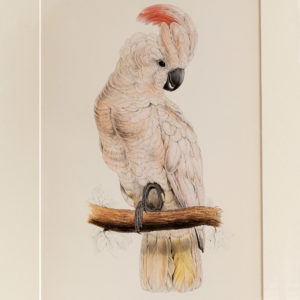
Parrots by Edward Lear – Salmon-crested Cockatoo
£275Parrots by Edward Lear – Salmon-crested Cockatoo
Edward Lear began his career as a zoological illustrator, working in the Parrot House at London Zoo. This resulted in the publication of Illustrations of the family of Psittacidae, or parrots, the greater part of them species hitherto unfigured in 1832. The first plates for the book were issued in 1830 when he was still only 18.£275 -
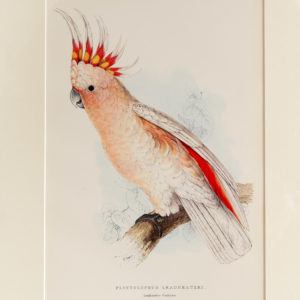
Parrots by Edward Lear – Leadbeater’s Cockatoo,
£275Parrots by Edward Lear – Leadbeater’s Cockatoo,
Edward Lear began his career as a zoological illustrator, working in the Parrot House at London Zoo. This resulted in the publication of Illustrations of the family of Psittacidae, or parrots, the greater part of them species hitherto unfigured in 1832. The first plates for the book were issued in 1830 when he was still only 18.£275 -

Sir Winston Churchill
£270Sir Winston Churchill
A framed, Mid 20th Century lithograph depicting Sir Winston Churchill in the manner of the controversial and now lost John Sutherland portrait of 1949.£270 -
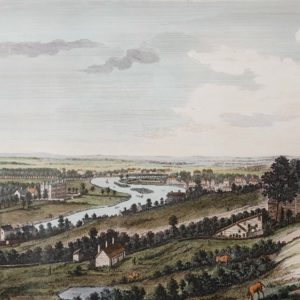
West View of Richmond from the Star & Garter
£270West View of Richmond from the Star & Garter
A framed and mounted, hand coloured engraving showing the Thames valley looking west over Richmond and Twickenham from a position besides the famous Star and Garter hotel at the top of Richmond Hill.£270 -
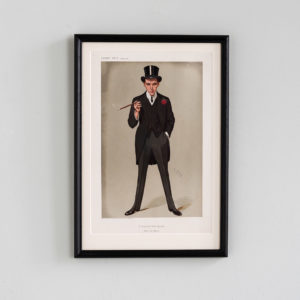
A Successful First Speech,
£270A Successful First Speech,
Framed chromolithograph by SPY (Sir Leslie Ward) picturing Mr Fredrick Edwin Smith, later 1st Earl of Birkenhead, MP for Liverpool Walton and boon companion of Sir Winston Churchill until his early death. The subtitle, 'Moab is my Washpot', is from psalm 108 and is a proverbial declaration of total triumph over vanquished foes. F.E Smith is famed in Parliamentary history for his maiden speech in the House, known as 'I Warn The Government', described by the late Paul Johnson as "without question the most famous maiden speech in history, quite unprecedented, and never equalled since." In it he accused the Liberal government of arrogance, dishonesty and heavy handedness after their landslide victory at the election of 1906. He managed to catch David Lloyd George in a clear untruth and won the begrudging admiration of all sides of the house. He declared, in response to a suggestion by Lloyd George to the churches of Wales that the Tories wanted to 'introduce slavery to the hills of Wales' that: "I have no means of judging how heaven will deal with persons who think it decent to make such suggestions. The distinction drawn by the Right Hon. Gentleman is more worthy of the county court than of the Treasury Bench." He then went on famously to declare: "I venture to warn the government that the people of this country will neither forget nor forgive a party which, in the heyday of its triumph, denies to the infant Parliament of the Empire one jot or tittle of that ancient liberty of speech which our predecessors in this House vindicated for themselves at the point of the sword." He was a, according to the ONDB a 'champion of hard-drinking patriotic men' in the face of the temperance movement before his early death of cirrhosis of the liver.£270 -
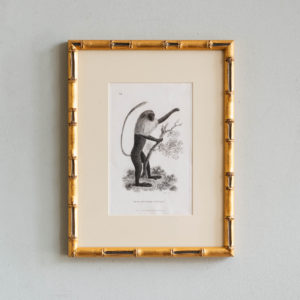
Monkeys – Full-Bottom Monkey,
£260 EachMonkeys – Full-Bottom Monkey,
The English Encyclopaedia was published in 1802 by George Kearsley and it gave an unusual insight into early 19th century new discoveries in zoology.£260 Each -
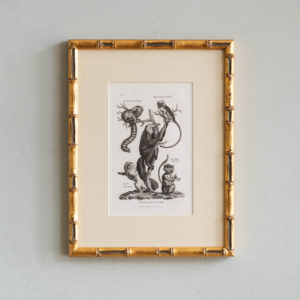
Monkeys – Striated Monkey, Red Tailed-Monkey,
£260 EachMonkeys – Striated Monkey, Red Tailed-Monkey,
The English Encyclopaedia was published in 1802 by George Kearsley and it gave an unusual insight into early 19th century new discoveries in zoology.£260 Each -
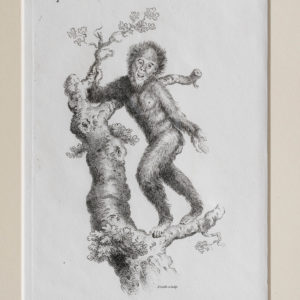
Monkeys – Oran Otan
£260 EachMonkeys – Oran Otan
The English Encyclopaedia was published in 1802 by George Kearsley and it gave an unusual insight into early 19th century new discoveries in zoology.£260 Each -
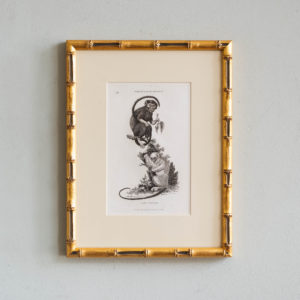
Monkeys – Great-Eared Monkey, and Fair Monkey,
£260 EachMonkeys – Great-Eared Monkey, and Fair Monkey,
The English Encyclopaedia was published in 1802 by George Kearsley and it gave an unusual insight into early 19th century new discoveries in zoology.£260 Each -
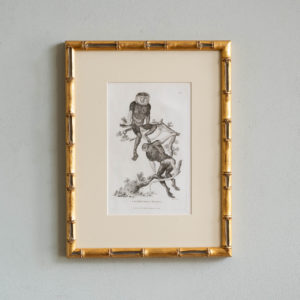
Monkeys – Cochinchina Monkey,
£260 EachMonkeys – Cochinchina Monkey,
The English Encyclopaedia was published in 1802 by George Kearsley and it gave an unusual insight into early 19th century new discoveries in zoology.£260 Each -
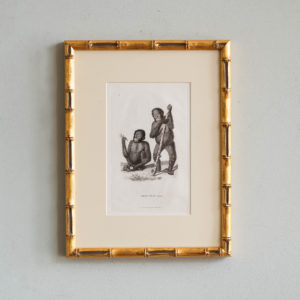
Monkeys – Oran Otan,
£260 EachMonkeys – Oran Otan,
The English Encyclopaedia was published in 1802 by George Kearsley and it gave an unusual insight into early 19th century new discoveries in zoology.£260 Each -
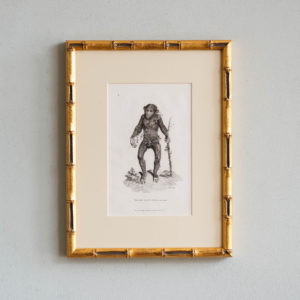
Monkeys – Black Oran-Otan,
£260 EachMonkeys – Black Oran-Otan,
The English Encyclopaedia was published in 1802 by George Kearsley and it gave an unusual insight into early 19th century new discoveries in zoology.£260 Each
Featured Items
-

Printemps by Marc Chagall, Verve Vol. 1 / No. 3.
£800Printemps by Marc Chagall, Verve Vol. 1 / No. 3.
The Verve Review was a purposefully luxurious. It ran from 1937 to 1960, but with only 38 editions available, due to the high degree of design and editorial work dedicated to each issue. Each edition contained unique lithographic prints, commissioned by the editor, and each cover a double-page lithograph elaborated by one of the artists contained within. It was the brainchild of its editor Stratis Eleftheriades, a Greek National who moved to Paris in the early thirties to take part in the growing Modernist movement, writing under the name of Teriade.£800 -
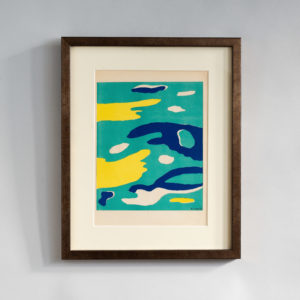
The Four Elements, Water by Fernand Leger, Verve Vol. 1 / No. 1.
£600The Four Elements, Water by Fernand Leger, Verve Vol. 1 / No. 1.
The Verve Review was a purposefully luxurious. It ran from 1937 to 1960, but with only 38 editions available, due to the high degree of design and editorial work dedicated to each issue. Each edition contained unique lithographic prints, commissioned by the editor, and each cover a double-page lithograph elaborated by one of the artists contained within. It was the brainchild of its editor Stratis Eleftheriades, a Greek National who moved to Paris in the early thirties to take part in the growing Modernist movement, writing under the name of Teriade.£600 -
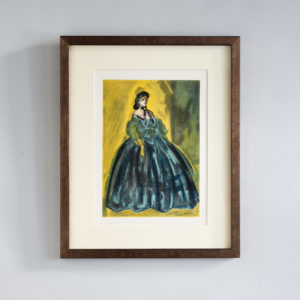
Portraits Part II by Constantin Guys, Verve Vol 2 / No. 5-6.
£500Portraits Part II by Constantin Guys, Verve Vol 2 / No. 5-6.
The Verve Review was a purposefully luxurious. It ran from 1937 to 1960, but with only 38 editions available, due to the high degree of design and editorial work dedicated to each issue. Each edition contained unique lithographic prints, commissioned by the editor, and each cover a double-page lithograph elaborated by one of the artists contained within. It was the brainchild of its editor Stratis Eleftheriades, a Greek National who moved to Paris in the early thirties to take part in the growing Modernist movement, writing under the name of Teriade.£500 -
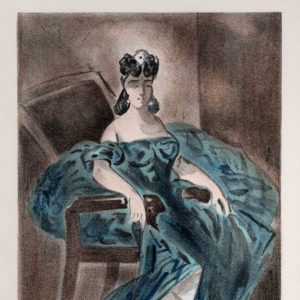
Portraits Part I by Constantin Guys, Verve Vol 2 / No. 5-6.
£500Portraits Part I by Constantin Guys, Verve Vol 2 / No. 5-6.
The Verve Review was a purposefully luxurious. It ran from 1937 to 1960, but with only 38 editions available, due to the high degree of design and editorial work dedicated to each issue. Each edition contained unique lithographic prints, commissioned by the editor, and each cover a double-page lithograph elaborated by one of the artists contained within. It was the brainchild of its editor Stratis Eleftheriades, a Greek National who moved to Paris in the early thirties to take part in the growing Modernist movement, writing under the name of Teriade.£500


